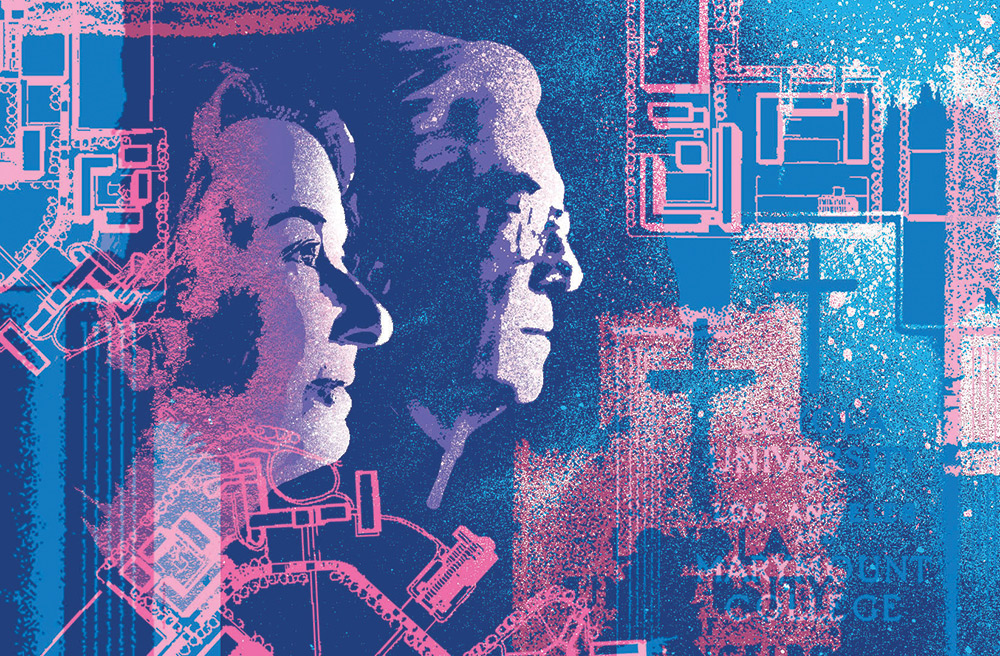
“No Marymount, no merger.” Those words were spoken by Raymunde McKay, R.S.H.M., president of Marymount College, to Renée Harrangue, R.S.H.M., as McKay outlined to Harrangue the sisters’ bottom-line negotiating stance with the Jesuits of Loyola University: If the new name did not include “Marymount,” there would be no merger. Fifty years ago, in 1973, two Catholic higher education institutions became one: Loyola University and Marymount College joined together to become a single university under the sponsorship of three religious entities: the Society of Jesus, the nuns of the Religious of the Sacred Heart of Mary, and the nuns of the Sisters of St. Joseph of Orange.
Both institutions had as many financial reasons as altruistic reasons — and perhaps more — to explore fundamental change together. Single-sex education was increasingly an albatross for both, and as early as 1964, McKay had informed Marymount’s regents that the college’s near-term enrollment needs represented a foundational survival challenge.
As early as 1965, three years before official collaboration, McKay and Loyola President Charles Casassa, S.J., were discussing the future of their institutions. Conversations eventually became negotiations, not only involving the leadership of Loyola and Marymount but also the Archbishop of Los Angeles, Cardinal James McIntyre, whose consent was essential. By fall 1968, co-instruction — two separate colleges each occupying the same physical space — had begun on the Westchester campus.
Mary Genino, R.S.H.M., a member of the LMU Board of Trustees and former superior of the Western American Province of the Religious of the Sacred Heart of Mary, says the merger remains a hallmark of the legacy of her order. “The merger was an expression of who we are: the higher education of young women. We recognized our gift as well as our limitations in moving forward. Educating women was a priority. We realized, given the time, that it had to be done in a different way.”
Michael Engh, S.J., chancellor at LMU who was a freshman in fall 1968, remembers that year as one convulsed by national and international turmoil: assassinations, anti-war protests, the Prague Spring, Black Power protests at the Summer Olympic Games in Mexico City. To Engh, changes on campus were not dwarfed by world events. Engh had taken AP courses on the Loyola campus a year before as a senior at nearby St. Bernard’s High School, so he was familiar with campus life before female students arrived to study. Having women on campus was a dramatic shift, he recalls, and the new campus environment was part of the change that seemed to be taking. place everywhere.
But the merger’s impact also extended far beyond bringing male and female students into the same classrooms, Engh says. An important institutional impact was that of Marymount benefactors who joined the LMU community: The Thomas and Dorothy Leavey family and their foundation and the Tenderich family. “Mary David Collins, R.S.H.M., cultivated philanthropist William H. Hannon for years,” he says.
Engh says the culture of LMU shifted dramatically as well because of a Who’s Who list of iconic figures who for decades shaped not only the institution but also students and alumni: Martin Byrne, R.S.H.M.; Lane Bove; Irma Brown; Barbara Busse; Joanne Connnolly, S.S.L.; Peg Dolan, R.S.H.M.; Kitty Harper, R.S.H.M.; Mary Beth Ingham, C.S.J.; Sharon Lacy; Mary Milligan, R.S.H.M.; Margaret Renehan, R.H.S.M.; Agnes Marie Schoen, C.S.J.; and Carol Sullivan, O.P.
“Their influence was subtle throughout the institution, but very impactful throughout the alumni. We may not think of all of them or even remember some, but in their time they had a lot to do with what the university has become,” he says.
To Genino, the success of the merger is the confluence of mission, charism and people. “Our tradition is education, and the tradition of the Jesuits is education. The charisms of the three congregations were complementary. There was an openness and receptivity to one another.”
